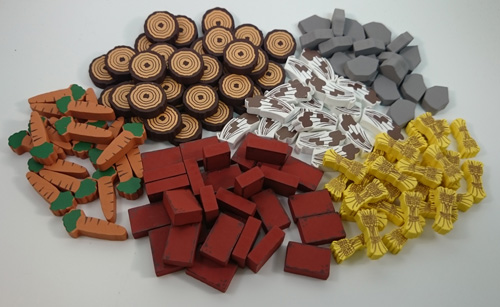 |
| Cool bits. Uncool pile for people to grab from... |
A lot of people like Plano style containers (which are cheap, easy to find, and come in a bazillion different sizes and often "configurable").
Others prefer to take foam core sheets and make their own. This lets them get in some crafting while creating storage and/or trays that exactly fit the original game box and meets their needs precisely. Some prefer to take this particular approach to the next level and use a vendor such as The Broken Token which has a large number of predesigned laser cut wooden inserts and storage systems.
And while all of those work for putting the game away, they aren't always great for the table. Sure, one container of all the goods in Agricola is easy to pass around. It also means you need one dedicated spot on the table for it to sit. Vertical sides and small spaces can make it harder to get some pieces out at times, and of course, for games with coins (money), making change constantly from one place can be a pain in the butt.
Other games need the bits in a certain spot to work well. The workers in Orléans really need to be next to their spot on the game board so that players can see what is left, because the count is important.
Which brings me back to Brian's post about some little parts trays. User swholmstead on Thingiverse created a little bits tray that is stackable (slightly sloped sides) and has a little funnel on it to make it easier to get the bits back into their baggies when the game is done (because there is no reason they aren't all in their own little baggies right?)
Well, seeing as I have access to a 3D printer (and had nothing else to do), I went out and grabbed the model and setup the printer to print my own stack of these and see how they worked out.
The first thing I realized as I began printing them - they aren't as big as I thought they might be. Obviously they don't need to be LARGE, but the real issue is they aren't very TALL. The reason that is an issue is that it means that each little tray doesn't hold very many parts. Sure, for coins or cardboard tokens, these probably will work wonderfully, but if I'm playing Agricola with those bits from the picture at the top of this post, then I'm not going to have very many out on the table (and/or I'm going to spill them out of the tray a lot handing them to someone).
On the plus side, smaller means not a lot of printing material. Once my four trays were done printing I weighed them out. The four trays weighed in the neighborhood of 50g.
One thing I get asked a fair amount - is 3D printing "worth it"? Well, if we take the cost of the actual printer and the electricity used out of the equation, then our cost for any given print boils down to the cost of the material used in printing. In this case, we are talking about a spool of PLA. Depending on color (which I don't generally care about), a 1000g spool of PLA can be found on Amazon (Prime) for about $20 (give or take a dollar or two - including shipping). So about $0.02/gram for printing means those four trays cost me roughly a dollar to print out. That seems pretty decent/reasonable. Print out a dozen and most games that I play are probably covered and cost me $3 and some time.
Except that I own a dozen silicon baking cups like these (except in black). A dozen cups like these cost a bit more ($6 for a dozen), but I think have a couple of advantages.
First off, they offer all the same benefits of the 3D printed trays - stackable and they make it easy to "pour" the bits back into baggies at the end of the game.
Next, they are taller and flexible. The added height means I can fit more bits into the cup (meeple bits need this). Being flexible means that it is generally a little easier to get the parts out of the cup (especially with bigger fingers). As I mentioned, this is an issue with Plano containers sometimes - there is no room to grab.
These aren't perfect by any means, they are soft, which means that if you just grab one side, you can spill everything out if you aren't paying attention, but I've found that they take up the least amount of table/board space while offering the best benefit for a reasonable cost (and no, I never use mine to make muffins).
So assuming you have access to a printer, whether to print or not really boils down to the kind of bits you are going be playing with for any given game. If your game has piles of chits or tokens, the trays might be the better choice. If your games are more "Deluxified" then you might want to think about the silicon cup route. That being said, it is always fun using the 3D printer and making things!
Be sure to check us out at PunchBoard Media!





No comments:
Post a Comment